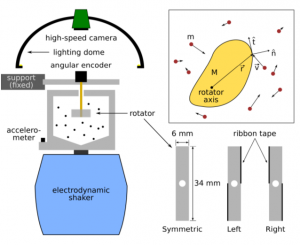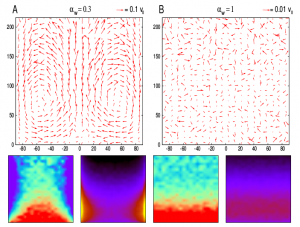Posts
Thermal convection in granular gases with dissipative lateral walls
Convection in molecular fluids is provided by the competition between gravity and an adverse temperature gradient (two thermostats, the hotter below, the colder above). In a granular gas it can be achieved by a single thermostat at the base, for instance a vibrating piston. Energy dissipation provides the “second thermostat” which spontaneously forms gradient and may stabilize a convective state. Here we have demonstrated that even the simple dissipation in the collision between grains and lateral walls is sufficient to trigger convection, without any critical threshold.… Read the rest
Brownian Ratchet in a Thermal Bath Driven by Coulomb Friction
A Brownian Ratchet is a small engine which is conceived to extract work from molecular fluctuations. Examples of Brownian Ratchets occur in the cell, see for instance this nice movie about kinesin.

As well explained by Richard Feynmann, a Brownian Ratchet cannot perform its own task in an equilibrium environment, i.e. the fluctuations feeding energy to the ratchet cannot originate from a single thermal bath, in accordance with the second principle of thermodynamics.… Read the rest
Granular Dynamics Laboratory
Since July 2010, the Granular Dynamics Laboratory is operative – originally in room “010” and (from november 2012) – in room “012” (ground floor of Fermi Building of the Physics Department) at the Sapienza unit of ISC. The laboratory includes two main experimental setups:
- Vertical vibration (2d and 3d granular experiments): an electrodynamic shaker LDS V455, which can reach a maximum acceleration of 105g, powered by a PA1000L power amplifier.
Granular Gases to explore Non-Equilibrium Statistical Mechanics
How do properties of molecular trajectories reflect on large scale transport and relaxation properties? Is it possible to directly and experimentally verify the Boltzmann’s program, connecting the microscopic level to the macroscopic description? Can we zoom into an out-of-equilibrium fluid and reveal, in the laboratory, its underlying microscopic reversibility? These are some of the questions addressed by the GRANULARCHAOS project, funded by an IDEAS grant (originally selected by ERC and then funded by italian FIRB) for five years.… Read the rest

